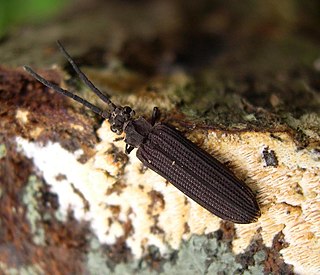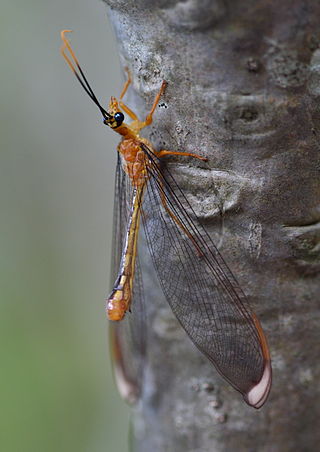
The Cupedidae are a small family of beetles, notable for the square pattern of "windows" on their elytra, which give the family their common name of reticulated beetles.

Anaxyelidae is a family of incense cedar wood wasps in the order Hymenoptera. It contains only one living genus, Syntexis, which has only a single species, native to Western North America. Fossils of the family extend back to the Middle Jurassic, belonging to over a dozen extinct genera, with a particularly high diversity during the Early Cretaceous. Syntexis lay eggs in the sapwood of conifers, preferring recently burnt wood.

Pelecinidae is a family of parasitic wasps in the superfamily Proctotrupoidea. It contains only one living genus, Pelecinus, with three species known from the Americas. The earliest fossil species are known from the Jurassic, and the group was highly diverse during the Cretaceous. Members of Pelecinus are parasitic on larval beetles, flies, green lacewings, and sawflies.

Nymphidae, sometimes called split-footed lacewings, are a family of winged insects of the order Neuroptera. There are 35 extant species native to Australia and New Guinea.

Coptoclavidae is an extinct family of aquatic beetles in the suborder Adephaga. The Coptoclavidae lived from the Late Triassic to the Early Cretaceous. Coptoclavidae is a member of the adephagan clade Dytiscoidea, which contains other aquatic beetles. Suggested reasons for their extinction to include the rise of teleost fish, or competition with Gyrinidae and Dytiscidae, which possess defensive secretions and sucking channels in the mandibles of larvae, which coptoclavids likely lacked. It has been suggested that the genus Timarchopsis and the subfamily Timarchopsinae are only distantly related to other coptoclavids based on cladistic analysis, with Timarchopsis being more closely related to geadephagans like carabids and trachypachids instead. Another study also suggested similarly for Coptoclavisca and possibly other coptoclaviscines.

Hemiphlebiidae is a family of damselflies. It contains only one extant species, the ancient greenling, native to Southern Australia and Tasmania. The fossil record of the group extends back to the Late Jurassic, making them the oldest known crown group damselflies.

Omma is a genus of beetles in the family Ommatidae. Omma is an example of a living fossil. The oldest species known, O. liassicum, lived during the final stage of the Triassic (Rhaetian), over 200 million years ago, though the placement of this species in Omma has been questioned. Numerous other fossil species are known from the Jurassic and Cretaceous of Europe and Asia. The only living species is Omma stanleyi, which is endemic to Australia. Three other extant species endemic to Australia that were formerly part of this genus were moved to the separate genus Beutelius in 2020.Omma stanleyi is strongly associated with wood, being found under Eucalyptus bark and exhibiting thanatosis when disturbed. Its larval stage and many other life details are unknown due to its rarity. Males are typically 14–20 mm in length, while females are 14.4-27.5 mm. Omma stanleyi occurs throughout eastern Australia from Victoria to Central Queensland.

Mesoraphidiidae is an extinct family of snakeflies in the suborder Raphidiomorpha. The family lived from the Late Jurassic through the Late Cretaceous and is known from twenty-five genera. Mesoraphidiids have been found as both compression fossils and as inclusions in amber. The family was first proposed in 1925 by the Russian paleoentomologist Andrey Vasilyevich Martynov based on Upper Jurassic fossils recovered in Kazakhstan. The family was expanded in 2002 by the synonymizing of several other proposed snakefly families. The family was divided into three subfamilies and one tribe in a 2011 paper, further clarifying the relationships of the included genera.

The Stenophlebiidae is an extinct family of medium-sized to large fossil odonates from the Upper Jurassic and Cretaceous period that belongs to the damsel-dragonfly grade ("anisozygopteres") within the stem group of Anisoptera. They are characterized by their long and slender wings, and the transverse shape of the discoidal triangles in their wing venation.

Spathiopterygidae is an extinct family of small parasitic wasps, known from the Cretaceous of Laurasia and Northern Gondwana. They are suggested to be members of Diaprioidea, in part due to their similarly reduced wing venation. Some members of the group reduced or lost the hindwings entirely.

Chresmodidae is an extinct family of Mesozoic insects within the superorder Polyneoptera.
Mesoblattinidae is an extinct, problematic family of cockroaches known from the Mesozoic. It was formerly considered a wastebasket taxon for Mesozoic cockroaches, but the family has subsequently been better defined, with many taxa transferred to Caloblattinidae. It is considered to have close affinities with Blattidae and Ectobiidae, as well as possibly Blaberidae. The family first appeared by the Early Jurassic. They are considered to represent amongst the oldest groups of modern cockroaches, and like them are thought to have laid oothecae.
Liberiblattinidae is an extinct family of cockroaches known from the Jurassic to Cretaceous. Some taxa, like Cryptoblatta and Hydrokhoohydra, are suggested to be semiaquatic. Spongistoma is suggested to be a nectarivore due to its unique sucking/sponging "proboscis" mouthparts. Some authors have suggested that the family is ancestral to Mantodea.
Yuripopovinidae is an extinct family of Coreoidea Hemipteran true bugs. Member species are known from the Early Cretaceous and early Late Cretaceous of Asia and northern Gondwana. Among the distinguishing characters are "the hemelytral costal vein apically much thickened and pterostigma-like, the corium with two large cells separated by one longitudinal straight vein." Dehiscensicoridae, described from the Yixian Formation of China has been deemed a junior synonym of Yuripopovinidae per Du et al. (2019). The family was named after Russian paleoentomologist Yuri Alexandrovich Popov.
Rhagionemestriidae is an extinct family of brachyceran flies known from the Jurassic and Cretaceous periods. It was first named as a subfamily of the Nemestrinidae by Ussatchov (1968), and was raised to full family status by Nagatomi and Yang (1998). They are considered to be closely related to the family Acroceridae. Similar to Acroceridae, members of the family possess a large hemispherical head, with eyes covering nearly all of the area.

Elcanidae are an extinct family of Mesozoic and early Cenozoic orthopterans. Members of the family are distinguished by the presence of spurs on the distal part of the metatibia, unique among orthopterans, these have been suggested to have been used for controlling gliding, swimming aids, or for jumping on water. The group combines characteristics from both major groups of orthopterans, with long antennae and nymphal morphology similar to Ensifera, but with wing venation and adult morphology more similar to Caelifera. Elcanidae is part of Elcanoidea, which is thought to have diverged from living orthopterans by the beginning of the Permian, around 300 million years ago. The family also includes Permelcanidae, known from the Early-Late Permian. The relationship of Elcanoidea to Ensifera and Caelifera is currently unresolved. Elcanids are known from the Late Triassic to Paleocene of Eurasia, North and South America. Some members of the group exhibited aposematic coloration.
Praeaulacidae is an extinct family of Mesozoic parasitic wasps in the suborder Evanioidea. It among the earliest known families of the group and is characterised by more complete wing venation in comparison to other members of the suborder. It has been found that Othniodellithidae is nested within Praeaulacidae via cladistic analysis.
Angarosphecidae is an extinct family of Mesozoic and early Cenozoic wasps in the superfamily Apoidea.
Mesochrysopidae is an extinct family of lacewings known from the Jurassic and Cretaceous periods. They are considered to be closely related to green lacewings of the family Chrysopidae. The family are also alternatively considered a paraphyletic grade leading up to crown Chrysopidae.
Lophioneurida is an extinct order of Thysanoptera, dating from the Carboniferous to the Cretaceous. It is likely paraphyletic, with modern thrips having evolved from members of the group.













